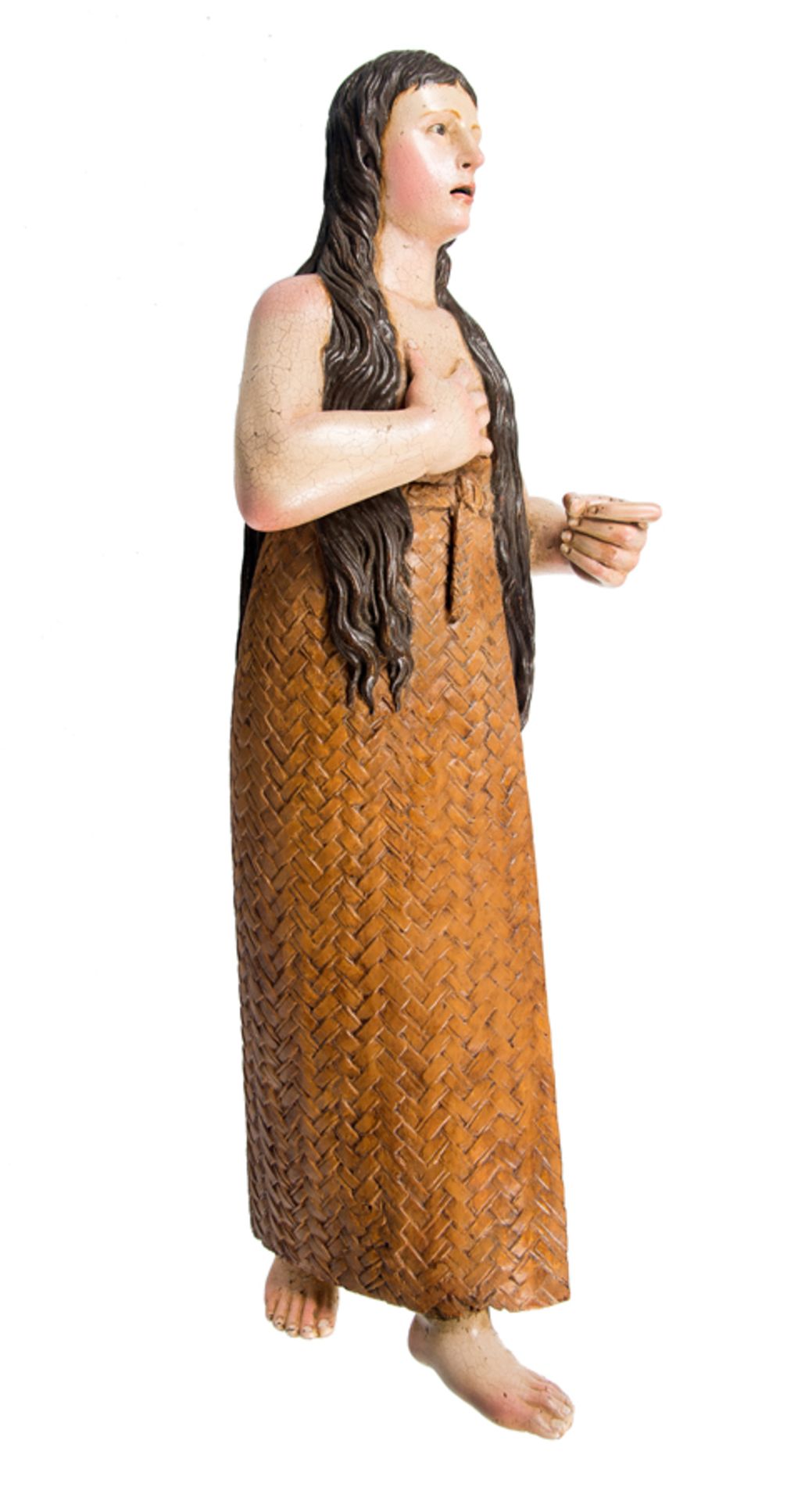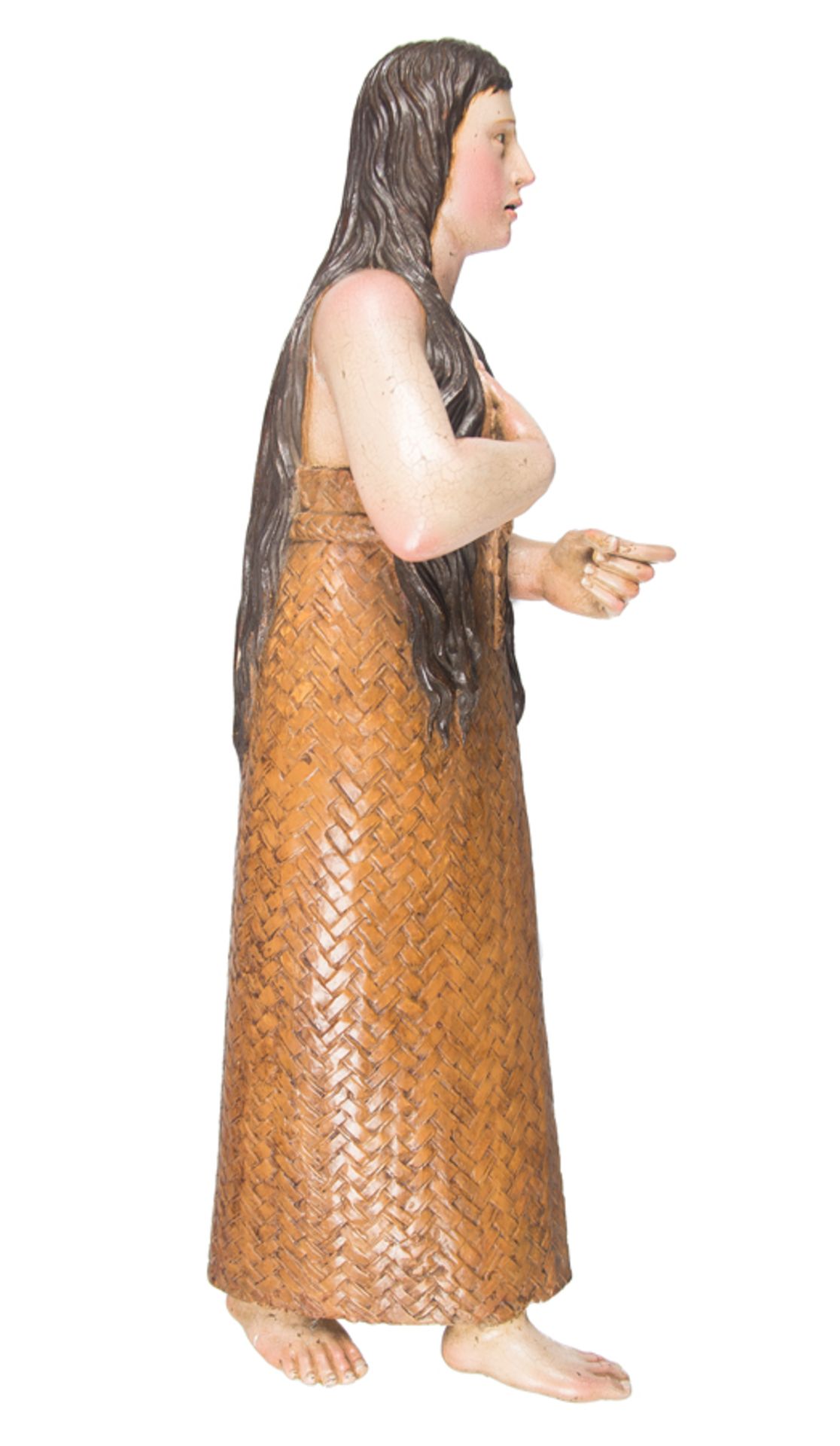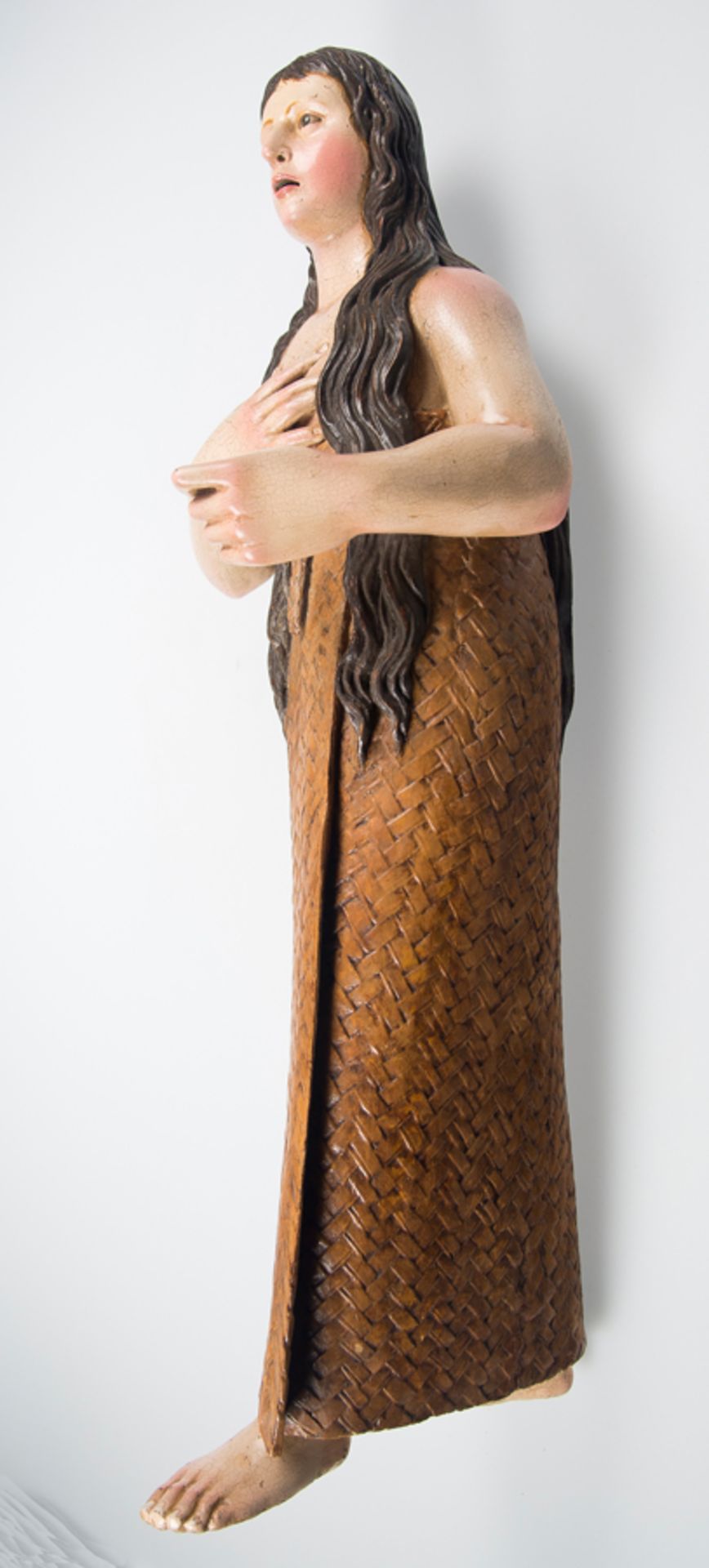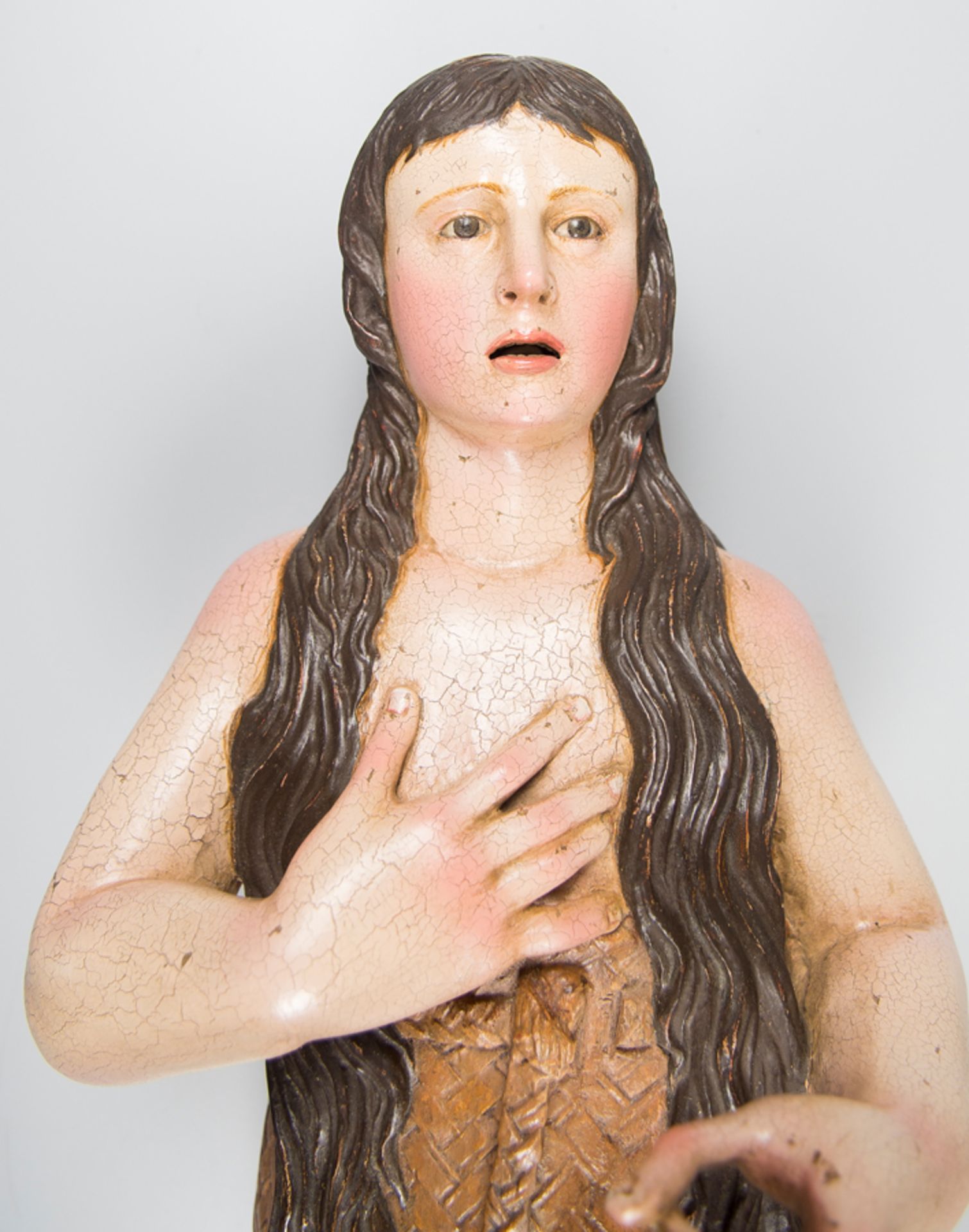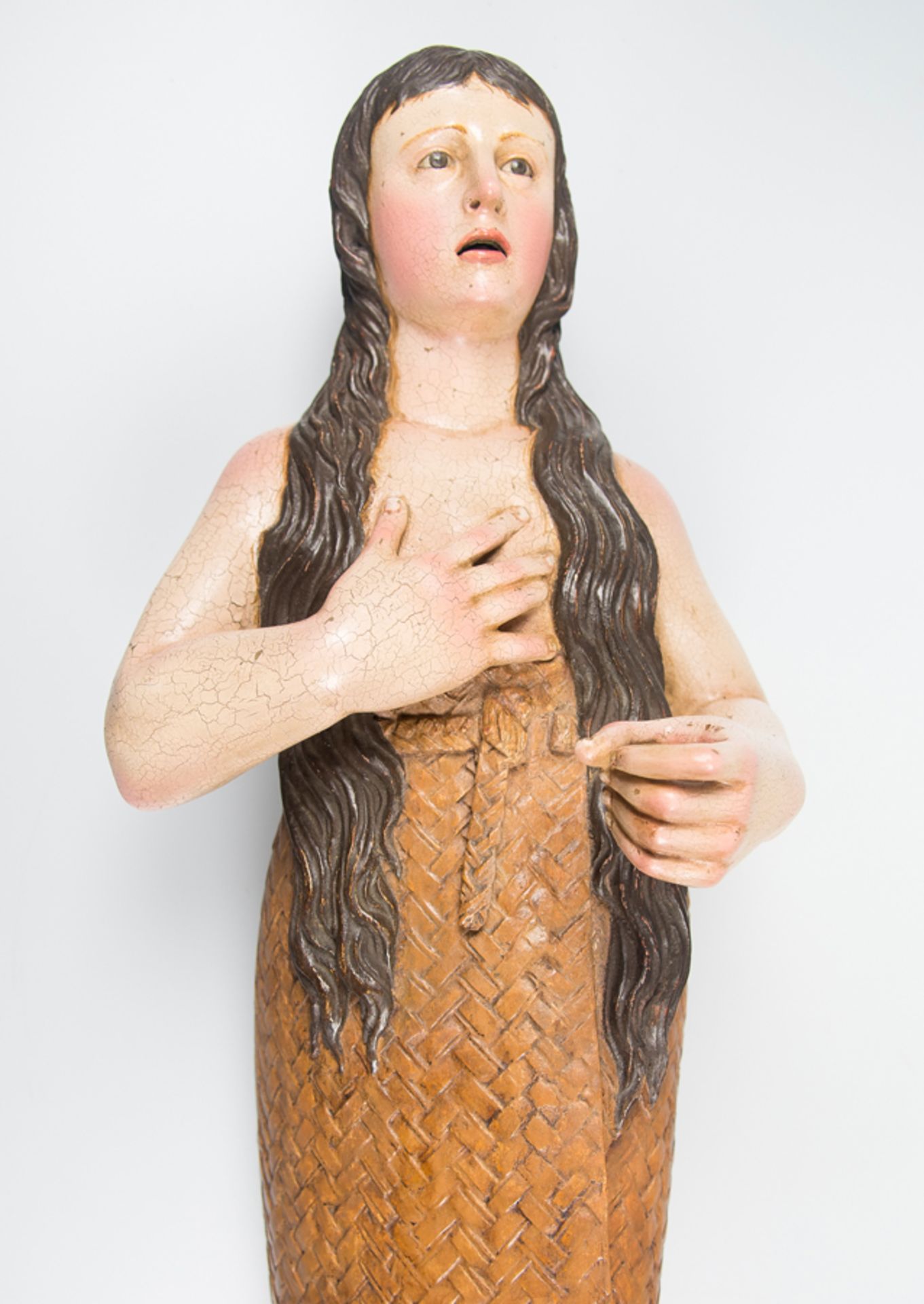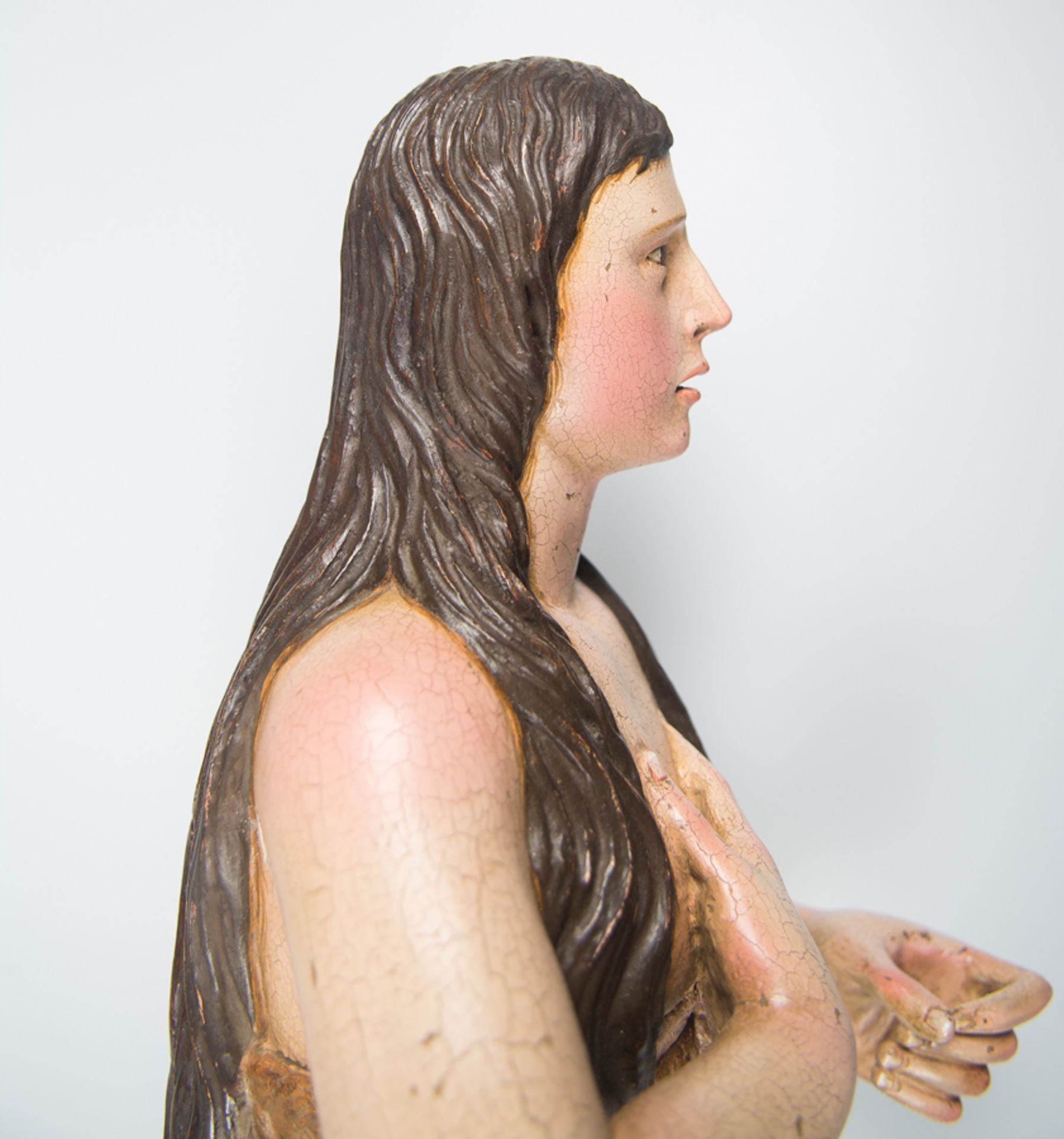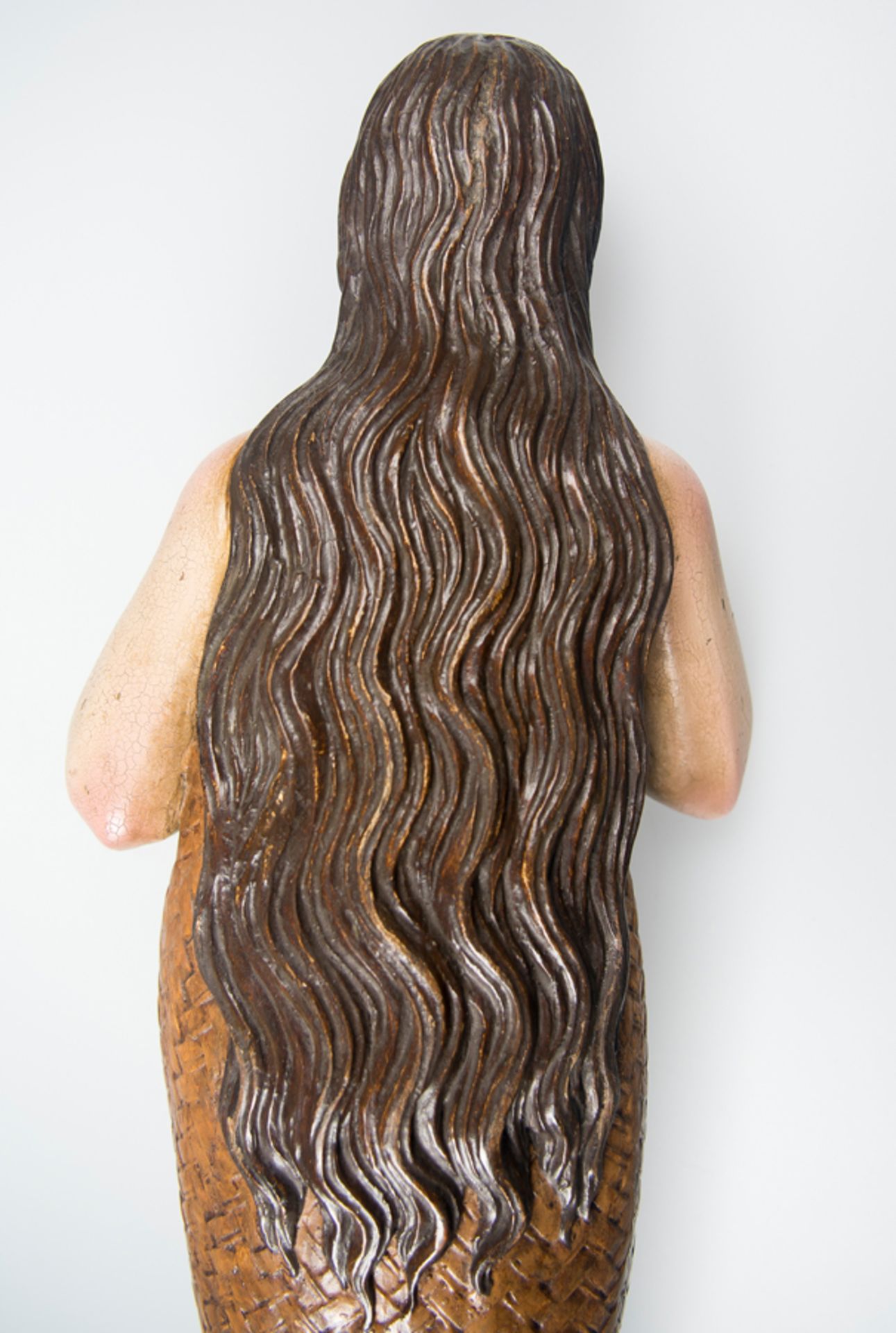36
Anonymous Castilian. Last quarter of the XVII century.
Anonymous Castilian. Last quarter of the XVII century.
"Saint Mary Magdalene".
Sculpture in carved and polychrome wood.
64,5 x 22 x 22 cm.
The iconography of the penitent Magdalene, prototype of the repentant woman, was one of the favourites ones of the Baroque.
Among all the representations that were made of the saint during this period, the model created and popularized by the Granada sculptor Pedro de Mena (1628-1688) stands out above all, and whose most outstanding example is the Penitent Magdalene (171 cm) that he sculpted in 1664 for the disappeared Casa Profesa in Madrid and which is currently on loan from the Prado Museum to the National Museum of Sculpture in Valladolid. The success of this sculpture, which is the quintessence of his refined and melancholic style, was due, in the words of Professor Lázaro Gila Medina, to the fact that "it fully complied with the wishes of the Society that its works should be sufficiently useful and effective for its evangelising and catechetical work, and in this case the Magdalene was an exceptional model, given that after an easy youth, after her encounter with Christ and sincere repentance, she would become his most faithful disciple, following him even after his Crucifixion". From the very moment of its execution, the Magdalena de los Jesuitas madrileños caused such astonishment and admiration that requests for copies and reproductions followed one after another, some of which were made by Mena himself.
Due to this fact, the iconographic type spread rapidly throughout much of Spain.The fame it achieved in Castilian lands, in general, and in Valladolid, in particular, was mainly due to the copy of the Magdalena (162 cm) owned by the Jesuit college of San Ignacio de Valladolid, and which was donated by Doña Magdalena de Pimentel, Marquise of Viana, in her will of 1702.Mena's model spread to exhaustion throughout the territories of the current communities of Madrid and Castile and Leon, and there are also numerous examples in the north of the peninsula (Galicia, Asturias, Cantabria and Navarra).
Returning to the sculpture that concerns us, we do not know its origin, although it is most likely from a church or convent of Castile and Leon.Mary Magdalene is effigied in a moment of intense rapture and meditation before a missing Crucifix that she would hold in her left hand.
On the other hand, the right hand rests delicately on her chest, as if holding her breath at the contemplation of the Crucified One.She stands upright, with her left leg forward, as if in the gesture of walking. In origin it is probable that she was located on a rocky place that evoked her hermit life, in which it is frequent that rocks, trees, streams, small hollows or caves, and diverse small animals like doves, snakes, frogs, etc... In addition, in occasions some of her attributes can appear on the rocky ground, case of the skull or even the bottle of perfumes.
He wears a palm mat that completely covers his body from the lower part of the bust to the ankles, leaving only the torso, arms and feet naked. The head, oval in shape, has facial features carved with great technical skill, highlighting the half-open mouth with thin lips, almond-shaped eyes or the nose with a straight septum and perforated nostrils to give greater credibility.The hair falls symmetrically on both sides of the face and down to below the waist in long, wavy, compact locks that evoke both her eremitic life and her femininity.Large locks cover part of her shoulders and back.
From the morphological features, essentially those present in his face, it is possible to assign this work to a Castilian sculptor -probably from Valladolid- who worked at the end of the last quarter of the 17th century.
We thank Mr. Javier Baladrón, doctor in Art History, for the identification and cataloguing of this work.
Anonymous Castilian. Last quarter of the XVII century.
"Saint Mary Magdalene".
Sculpture in carved and polychrome wood.
64,5 x 22 x 22 cm.
The iconography of the penitent Magdalene, prototype of the repentant woman, was one of the favourites ones of the Baroque.
Among all the representations that were made of the saint during this period, the model created and popularized by the Granada sculptor Pedro de Mena (1628-1688) stands out above all, and whose most outstanding example is the Penitent Magdalene (171 cm) that he sculpted in 1664 for the disappeared Casa Profesa in Madrid and which is currently on loan from the Prado Museum to the National Museum of Sculpture in Valladolid. The success of this sculpture, which is the quintessence of his refined and melancholic style, was due, in the words of Professor Lázaro Gila Medina, to the fact that "it fully complied with the wishes of the Society that its works should be sufficiently useful and effective for its evangelising and catechetical work, and in this case the Magdalene was an exceptional model, given that after an easy youth, after her encounter with Christ and sincere repentance, she would become his most faithful disciple, following him even after his Crucifixion". From the very moment of its execution, the Magdalena de los Jesuitas madrileños caused such astonishment and admiration that requests for copies and reproductions followed one after another, some of which were made by Mena himself.
Due to this fact, the iconographic type spread rapidly throughout much of Spain.The fame it achieved in Castilian lands, in general, and in Valladolid, in particular, was mainly due to the copy of the Magdalena (162 cm) owned by the Jesuit college of San Ignacio de Valladolid, and which was donated by Doña Magdalena de Pimentel, Marquise of Viana, in her will of 1702.Mena's model spread to exhaustion throughout the territories of the current communities of Madrid and Castile and Leon, and there are also numerous examples in the north of the peninsula (Galicia, Asturias, Cantabria and Navarra).
Returning to the sculpture that concerns us, we do not know its origin, although it is most likely from a church or convent of Castile and Leon.Mary Magdalene is effigied in a moment of intense rapture and meditation before a missing Crucifix that she would hold in her left hand.
On the other hand, the right hand rests delicately on her chest, as if holding her breath at the contemplation of the Crucified One.She stands upright, with her left leg forward, as if in the gesture of walking. In origin it is probable that she was located on a rocky place that evoked her hermit life, in which it is frequent that rocks, trees, streams, small hollows or caves, and diverse small animals like doves, snakes, frogs, etc... In addition, in occasions some of her attributes can appear on the rocky ground, case of the skull or even the bottle of perfumes.
He wears a palm mat that completely covers his body from the lower part of the bust to the ankles, leaving only the torso, arms and feet naked. The head, oval in shape, has facial features carved with great technical skill, highlighting the half-open mouth with thin lips, almond-shaped eyes or the nose with a straight septum and perforated nostrils to give greater credibility.The hair falls symmetrically on both sides of the face and down to below the waist in long, wavy, compact locks that evoke both her eremitic life and her femininity.Large locks cover part of her shoulders and back.
From the morphological features, essentially those present in his face, it is possible to assign this work to a Castilian sculptor -probably from Valladolid- who worked at the end of the last quarter of the 17th century.
We thank Mr. Javier Baladrón, doctor in Art History, for the identification and cataloguing of this work.
Beauty and Devotion. Picasso between the Old and New World.
Auktionsdatum
Ort der Versteigerung
Generelle Versandinformationen vom Auktionshaus verfügbar
The purchase price includes the delivery of the lots in the venue of the auction. Transporting to other destinations is at the own risk of the client. The customer must contact "LST", to give the corresponding instructions for such transporting. "LST" is not responsible for the packaging or any accident incurred during transportation.
Wichtige Informationen
AGB
CONDITIONS OF THE AUCTION:
I. REGISTRATION. To bid in the room customers must register at the beginning, filling out a form and picking a number that will identify them during the auction. Customers may be required to register in bank references or other guarantee system and if they do not prove the solvency "LST" will not accept bids and award the auction.
II. WRITTEN BIDS. "LST" will accept written bids, which will be formalized in the form provided by the room until the day before the auction. In such auctions, the room will bid in name of the client until the maximum stated in the offer and always at the lowest possible price. If there are two or more bids for the same amount, the one placed first will have the priority. Written bids received in advance, will have priority on the day of the auction.
III. TELEPHONE BIDS. "LST" will allow telephone bids, if interested people contact "LST" days before the auction providing personal data, ID card and the phone number which will be used by the staff of "LST" to call at the time of the auction. The buyer, within all the legal rights is making an offer for the asking price, when applies for telephone bid. "LST" will not take responsibility for any technical defects beyond its control, which may prevent to contact successfully the bidder during the auction.
IV. AUCTIONEER. The auction will be conducted by an auctioneer, director of the auction will be judge and arbitrator of it with full authority in its development, will award the lots to the highest bidder and is able to settle any controversy concerning lots sale, reject bids, divide lots or group them and remover objects from the room. Will be able to, if it is deemed suitable, not accept bids on the auction. His decision will be unappealable.
V. SALE OF LOTS. The lots are awarded to the highest bidder. Once the auctioneer blows the hammer, the buyer becomes responsible of the lot purchased, exempting "LST" of liability to for any damage and / or accidents that may occur. No refunds of lots.
VI. STARTING PRICE. The amount shown in the catalogue as the starting price for each lot will be, as a rule, the minimum selling price, except for exceptional cases where a reservation may be agreed upon with the seller or it set discretionary by the room.
VII. SCALE OF BIDS. The bids are set according to the following scale:
From 50.-€ to 200.-€…………………………………………..at 10.-€
From 200.-€ to 500.-€…………………………………… …25 in 25.-€
From 500.-€ to 1.000.-€………………………………..…..….50 in 50.-€
From 1.000.-€ to 2.000.-€………………………………..…100 in 100.-€
From 2.000.-€ to 5.000.-€……………………………….….250 in 250.-€
From 5.000.-€ to 10.000.-€…………………………………500 in 500.-€
From 10.000.-€ to 20.000.-€……………………………1.000 in 1.000.-€
From 20.000.-€ to 50.000.-€……………………………2.500 in 2.500.-€
From 50.000.-€ to 100.000.-€…………………………..5.000 in 5.000.-€
From 100.000.-€ to 100.000.-€………………………10.000 in 10.000.-€
From 200.000.-€ to 200.000.-€………………………25.000 in 25.000.-€
From 500.000.-€ to 500.000.-€………………………50.000 in 50.000.-€
VIII. RIGHT OF ADMISION. "LST" reserves the right to admission to the auction room and to reject, at its judgment, any purchase order, from clients whose solvency is not duly proved as well as not to sale auctions.
IX. SALE PRICES. The successful bidder of one or more lots must pay "LST" the final sale price achieves at auction, plus the 24,5 % plus 21% VAT on the commission, at total 29,65 % on Hammer Price.
X. CATALOG DATA. The catalogue data are obtained in order to careful research and advice, however, any responsibility is afforded about its accuracy. The lots will be auctioned in the state in which they are, not accepting any claims in restorations, breakage, damage, imperfections and, even description or numbering mistakes in the catalogue, in case of it, being the burden of the buyers to make sure before the auction that the description matches with their personal opinion about respective lot. The exhibition of the lots is intended to allow a perfect review and study of them.
XI. PAYMENT AND REMOVAL OF LOTS. Payment and removal of the lots will be held no later than five days following the auction. After this period expire without having the buyer removed the lot or lots purchases, it will accrue an expense of custody of 6 euros per day on each lot.
15 days after the auction without having the buyer paid and removes the sold lots, "LST" will inform the seller and there will begin judicial proceeding in order to obtain payment. The delay in payment by the purchaser of his/her sold lots will carry an interest increase at a rate of 1,5% per month.
XII. DELIVERY OF LOTS. The purchase price includes the delivery of the lots in the venue of the auction. Transporting to other destinations is at the own risk of the client. The customer must contact "LST", to give the corresponding instructions for such transporting. "LST" is not responsible for the packaging or any accident incurred during transportation.
XIII. RIGHT OF FIRT REFUSAL AND REPURCHASE. "LST" in order to article 38 of "Ley 16/1985 de 25 Junio del Patrimonio Histórico Español" (BOE. 155 June 29, 1985), will notify in advance to the Ministry of Culture, the content of their catalogues. Concerning the lots subject to the legislation referred to in the preceding paragraph, the Administration may exercise the rights of first refusal and repurchase according to the law. "LST" will watch over the protection of Artistic, Historical and Bibliographical Heritage of Spain. For customers out of European Community, a tax for export is required by the Administration.
XIV. VALUE ADDED TAX (I.V.A). This tax will be accrued on commissions of "LST" for buyers, using the rates prevailing on the date of the auction.
XV. DATA PROTECTION. In order to the "Ley 15/1999 de 13 de Diciembre, de Protección de Datos de Carácter Personal", the client authorize "LST", the inclusion of their data in a customer file, and for the promotion by "LST" of the objects at all times the rights of access, rectification or deletion of personal data by sending the appropriate request to the following address: LA SUITE SUBASTAS, C/ Conde Salvatierra, 8, 08006. Barcelona.
XVI. EXPRESS LEGAL JURISDICTION. These Conditions are governed by and interpreted in accordance with the rules of Spanish law. The mere act of participating in the auction as seller, buyer or bidder, implies acceptance of these Terms and Conditions.
Sales operations are understood to be held at the registered office of "LST", C/ Conde de Salvatierra, 8, 08006. Any dispute shall be taken to the competent courts of Barcelona, expressly waiving any other jurisdiction, in accordance with Article 55 of the "Ley de Enjuiciamiento Civil".





















